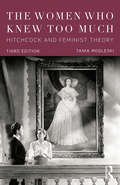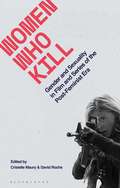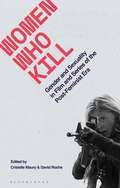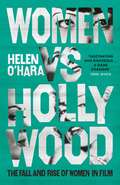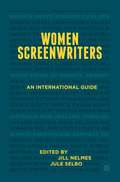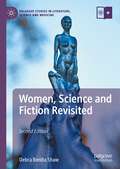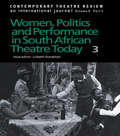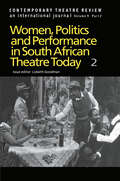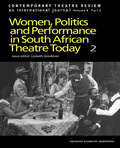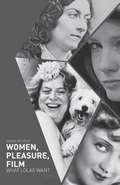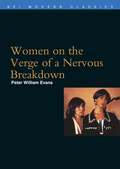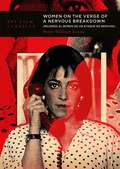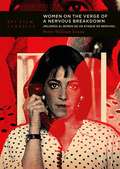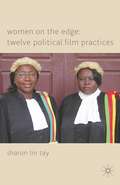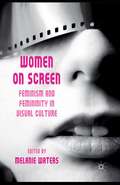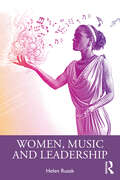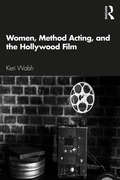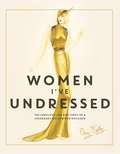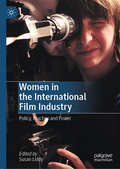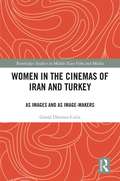- Table View
- List View
The Women Who Knew Too Much: Hitchcock and Feminist Theory
by Tania ModleskiOriginally published in 1988, The Women Who Knew Too Much remains a classic work in film theory and feminist criticism. The book consists of a theoretical introduction and analyses of seven important films by Alfred Hitchcock, each of which provides a basis for an analysis of the female spectator as well as of the male spectator. Modleski considers the emotional and psychic investments of men and women in female characters whose stories often undermine the mastery of the cinematic "master of suspense." The third edition features an interview with the author by David Greven, in which he and Modleski reflect on how feminist and queer approaches to Hitchcock studies may be brought into dialogue. A teaching guide and discussion questions by Ned Schantz help instructors and students to delve into this seminal work of feminist film theory.
Women Who Kill: Gender and Sexuality in Film and Series of the Post-Feminist Era (Library of Gender and Popular Culture)
by David Roche Cristelle MauryWomen Who Kill explores several lines of inquiry: the female murderer as a figure that destabilizes order; the tension between criminal and victim; the relationship between crime and expression (or the lack thereof); and the paradox whereby a crime can be both an act of destruction and a creative assertion of agency. In doing so, the contributors assess the influence of feminist, queer and gender studies on mainstream television and cinema, notably in the genres (film noir, horror, melodrama) that have received the most critical attention from this perspective. They also analyse the politics of representation by considering these works of fiction in their contexts and addressing some of the ambiguities raised by postfeminism.The book is structured in three parts: Neo-femmes Fatales; Action Babes and Monstrous Women. Films examined include White Men Are Cracking Up (1994); Hit & Miss (2012); Gone Girl (2014); Terminator (1984); The Walking Dead (2010); Mad Max: Fury Road (2015); Contagion (2011) and Ex Machina(2015) among others.
Women Who Kill: Gender and Sexuality in Film and Series of the Post-Feminist Era (Library of Gender and Popular Culture)
Women Who Kill explores several lines of inquiry: the female murderer as a figure that destabilizes order; the tension between criminal and victim; the relationship between crime and expression (or the lack thereof); and the paradox whereby a crime can be both an act of destruction and a creative assertion of agency. In doing so, the contributors assess the influence of feminist, queer and gender studies on mainstream television and cinema, notably in the genres (film noir, horror, melodrama) that have received the most critical attention from this perspective. They also analyse the politics of representation by considering these works of fiction in their contexts and addressing some of the ambiguities raised by postfeminism.The book is structured in three parts: Neo-femmes Fatales; Action Babes and Monstrous Women. Films examined include White Men Are Cracking Up (1994); Hit & Miss (2012); Gone Girl (2014); Terminator (1984); The Walking Dead (2010); Mad Max: Fury Road (2015); Contagion (2011) and Ex Machina(2015) among others.
Women vs Hollywood: The Fall and Rise of Women in Film
by Helen O'Hara'A fascinating polemic' Sunday Times 'A powerful, sobering and vital work' The Mail on Sunday 'A page-turning read, peppered with humour' Sight & Sound'A must read' Edgar WrightA call to arms from Empire magazine's 'geek queen', Helen O'Hara, that explores women's roles - both in front of and behind the camera - since the birth of Hollywood, how those roles are reflected within wider society and what we can do to level the playing field.The dawn of cinema was a free-for-all, and there were women who forged ahead in many areas of filmmaking. Early pioneers like Dorothy Arzner (who invented the boom mic, among other innovations) and Alice Guy-Blaché shaped the way films are made. But it wasn't long before these talented women were pushed aside and their contributions written out of film history. How and why did this happen?Hollywood was born just over a century ago, at a time of huge forward motion for women's rights, yet it came to embody the same old sexist standards. Women found themselves fighting a system that feeds on their talent, creativity and beauty but refuses to pay them the same respect as their male contemporaries - until now...The tide has finally begun to turn. A new generation of women, both in front of and behind the camera, are making waves in the industry and are now shaping some of the biggest films to hit our screens. There is plenty of work still needed before we can even come close to gender equality in film - but we're finally headed in the right direction.In Women vs Hollywood: The Fall and Rise of Women in Film, Empire's 'geek queen' Helen O'Hara takes a closer look at the pioneering and talented women of Hollywood and their work in film since Hollywood began. Equal representation in film matters because it both reflects and influences wider societal gender norms. In understanding how women were largely written out of Hollywood's own origin story, and how the films we watch are put together, we can finally see how to put an end to a picture that is so deeply unequal - and discover a multitude of stories out there just waiting to be told.
Women Screenwriters: An International Guide
by Jill NelmesWomen Screenwriters is a study of more than 300 female writers from 60 nations, from the first film scenarios produced in 1986 to the present day. Divided into six sections by continent, the entries give an overview of the history of women screenwriters in each country, as well as individual biographies of its most influential.
Women, Science and Fiction Revisited (Palgrave Studies in Literature, Science and Medicine)
by Debra Benita ShawWomen, Science and Fiction Revisited is an analysis of selected science fiction novels and short stories written by women over the past hundred years from the point of view of their engagement with how science writes the world. Beginning with Charlotte Perkins Gilman's Herland (1918) and ending with N K Jemisin's The City We Became (2020), Debra Benita Shaw explores the re-imagination of gender and race that characterises women's literary crafting of new worlds. Along the way, she introduces new readings of classics like Ursula Le Guin's The Left Hand of Darkness and Margaret Atwood's The Handmaid's Tale, examining the original novels in the context of their adaptation to new media formats in the twenty-first century. What this reveals is a consistent preoccupation with how scientific ideas can be employed to challenge existing social structures and argue for change.
Women, Politics and Performance in South African Theatre Today Vol 3 (Contemporary Theatre Review Ser. #Vols. 9, Pts. 3.)
by Lizbeth GoodmanThis title available in eBook format. Click here for more information.Visit our eBookstore at: www.ebookstore.tandf.co.uk.
Women, Politics and Performance in South African Theatre Today Vol 3
by Lizbeth GoodmanThis title available in eBook format. Click here for more information.Visit our eBookstore at: www.ebookstore.tandf.co.uk.
Women, Politics and Performance in South African Theatre Today: Volume 2
by Goodman LFirst Published in 1999. Routledge is an imprint of Taylor & Francis, an informa company.
Women, Politics and Performance in South African Theatre Today: Volume 2
by Goodman LFirst Published in 1999. Routledge is an imprint of Taylor & Francis, an informa company.
Women, Pleasure, Film: What Lolas Want
by Simon RichterThe Lola film is a distinct subgenre of the woman's film in which woman's claim to pleasure is entertained without recourse to the figure of the femme fatale. Lola embodies a recognizable set of characteristics through which over time a select group of directors, actors, and audiences have responded in ways that do not succumb to the imperatives of gender. There are over thirty-five Lola films, starting with Marlene Dietrich in The Blue Angel: many are German, others are French, American, British, Italian, and Spanish, but her claim has also resonated in Argentina, China, Egypt, Mexico, Thailand, and the Philippines. Lola can be working class, lesbian, transgender, ethnic, suburban, or any combination. This book examines Lola as a specific and enduring aspect of the early twentieth-century "new woman": woman's forthright claim to pleasure on her own terms, liberated, if only as a cinematic fantasy, from the usual constraints of sex and gender.
Women on the Verge of a Nervous Breakdown (BFI Film Classics)
by Peter William EvansThis text analyses director Pedro Almodovar's insights into gender, sexuality and subjectivity in his film Women on the Verge of a Nervous Breakdown. The author draws on a range of psychoanalytic and critical concepts and sees the film as an account of the often tyrannical spell of sexual desire, of the anxieties of relationships and families, but also of the possibilities of personal liberation. Peter William Evans also discusses the recent history of Spain and ties the film's concerns into the social revolution which occurred after the death of Franco.
Women on the Verge of a Nervous Breakdown (BFI Film Classics)
by Peter William EvansThis text analyses director Pedro Almodovar's insights into gender, sexuality and subjectivity in his film Women on the Verge of a Nervous Breakdown. The author draws on a range of psychoanalytic and critical concepts and sees the film as an account of the often tyrannical spell of sexual desire, of the anxieties of relationships and families, but also of the possibilities of personal liberation. Peter William Evans also discusses the recent history of Spain and ties the film's concerns into the social revolution which occurred after the death of Franco.
Women on the Verge of a Nervous Breakdown (BFI Film Classics)
by Peter William EvansPedro Almodóvar's 1988 black comedy-melodrama Women on the Verge of a Nervous Breakdown established its director as one of the most exciting of European film-making talents. An often hilarious study of sexual mores, Women on the Verge has a central character, Pepa (Carmen Maura), as warm and richly drawn as any modern film heroine. Made strong and self-reliant by suffering in a troubled relationship, Pepa is the centre of a network of lovers, friends and family who represent a vivid cross-section of Spanish society. Peter William Evans provides a formidable analysis of Almodóvar's insights into gender, sexuality and identity. Evans sees Women on the Verge as concerned with the often tyrannical spell of sexual desire and the anxieties of relationships and families, but also with the possibilities for personal liberation. He discusses the film in the context of the history of Spain and the social revolution that occurred after the death of Franco. In his foreword to this new edition, Evans reflects upon Women on the Verge in the light of Almodóvar's subsequent films, and the impact of Carmen Maura's performance as Pepa on the representation of women in Spanish cinema.
Women on the Verge of a Nervous Breakdown (BFI Film Classics)
by Peter William EvansPedro Almodóvar's 1988 black comedy-melodrama Women on the Verge of a Nervous Breakdown established its director as one of the most exciting of European film-making talents. An often hilarious study of sexual mores, Women on the Verge has a central character, Pepa (Carmen Maura), as warm and richly drawn as any modern film heroine. Made strong and self-reliant by suffering in a troubled relationship, Pepa is the centre of a network of lovers, friends and family who represent a vivid cross-section of Spanish society. Peter William Evans provides a formidable analysis of Almodóvar's insights into gender, sexuality and identity. Evans sees Women on the Verge as concerned with the often tyrannical spell of sexual desire and the anxieties of relationships and families, but also with the possibilities for personal liberation. He discusses the film in the context of the history of Spain and the social revolution that occurred after the death of Franco. In his foreword to this new edition, Evans reflects upon Women on the Verge in the light of Almodóvar's subsequent films, and the impact of Carmen Maura's performance as Pepa on the representation of women in Spanish cinema.
Women on the Edge: Twelve Political Film Practices
by S. TayWomen on the Edge re-envisions women's cinema as contemporary political practices by exploring the works of twelve filmmakers. Moving on from the 1970s feminist adage that the personal is political, Sharon Lin Tay argues that contemporary women's cinema must exceed the personal to be politically relevant and ethically cogent.
Women on Screen: Feminism and Femininity in Visual Culture
by Melanie WatersA timely intervention into debates on the representation of feminist and feminine identities in contemporary visual culture. The essays in this collection interrogate how and why certain formulations of feminism and femininity are currently prevalent in mainstream cinema and television, offering new insights into postfeminist media phenomena.
Women, Music and Leadership
by Helen RusakWomen, Music and Leadership offers a wide-ranging survey of women in musical leadership and their experiences, highlighting women’s achievements and considering how they negotiate the challenges of the leadership space in music. Women have always participated in music as performers, teachers, composers and professionals, but remain underrepresented in leadership positions. Covering women’s leadership across a wide variety of roles and musical genres, this book addresses women in classical music, gospel, blues, jazz, popular music, electronic music and non-Western musical contexts, and considers women working as composers, as conductors, and in music management and the music business. Each chapter includes several case studies of women’s careers, exploring their groundbreaking contributions to music and the challenges they faced as leaders. Connecting management theory and leadership research with feminist musicology, this book paints a new picture of women’s major contributions as leaders in music and their ongoing struggles for equity. It will be relevant to students and scholars in arts and music management, as well as all those studying music, gender or leadership, and women music professionals.
Women, Music and Leadership
by Helen RusakWomen, Music and Leadership offers a wide-ranging survey of women in musical leadership and their experiences, highlighting women’s achievements and considering how they negotiate the challenges of the leadership space in music. Women have always participated in music as performers, teachers, composers and professionals, but remain underrepresented in leadership positions. Covering women’s leadership across a wide variety of roles and musical genres, this book addresses women in classical music, gospel, blues, jazz, popular music, electronic music and non-Western musical contexts, and considers women working as composers, as conductors, and in music management and the music business. Each chapter includes several case studies of women’s careers, exploring their groundbreaking contributions to music and the challenges they faced as leaders. Connecting management theory and leadership research with feminist musicology, this book paints a new picture of women’s major contributions as leaders in music and their ongoing struggles for equity. It will be relevant to students and scholars in arts and music management, as well as all those studying music, gender or leadership, and women music professionals.
Women, Method Acting, and the Hollywood Film
by Keri WalshWomen, Method Acting, and the Hollywood Film is the first study dedicated to understanding the work of female Method actors on film. While Method acting on film has typically been associated with the explosive machismo of actors like Marlon Brando and Robert De Niro, this book explores an alternate tradition within the Method—the work that women from the Actors Studio did in Hollywood. Covering the period from the end of the Second World War until the 1970s, this study shows how the women associated with the Actors Studio increasingly used Method acting in ways that were compatible with their burgeoning feminist political commitments and developed a style of feminist Method acting. The book examines the complex intersection of Method acting, sexuality, and gender by analyzing performances such as Kim Hunter’s in A Streetcar Named Desire, Julie Harris’s in The Member of the Wedding, Shelley Winters’s in The Big Knife, Geraldine Page’s in Sweet Bird of Youth, and Jane Fonda’s in Coming Home. Challenging the longstanding assumption that Method acting’s approaches were harmful to women and incompatible with feminism, this book argues that some of Hollywood’s most interesting female actors, and leading feminists, emerged from the Actors Studio in the period between the 1950s and the 1970s. Written for students and scholars of Film Studies, Cultural Studies, Theatre and Performance Studies, and Gender Studies, Women, Method Acting, and the Hollywood Film reshapes the way we think of a central strain in American screen acting, and in doing so, allows women a new stake in that tradition.
Women, Method Acting, and the Hollywood Film
by Keri WalshWomen, Method Acting, and the Hollywood Film is the first study dedicated to understanding the work of female Method actors on film. While Method acting on film has typically been associated with the explosive machismo of actors like Marlon Brando and Robert De Niro, this book explores an alternate tradition within the Method—the work that women from the Actors Studio did in Hollywood. Covering the period from the end of the Second World War until the 1970s, this study shows how the women associated with the Actors Studio increasingly used Method acting in ways that were compatible with their burgeoning feminist political commitments and developed a style of feminist Method acting. The book examines the complex intersection of Method acting, sexuality, and gender by analyzing performances such as Kim Hunter’s in A Streetcar Named Desire, Julie Harris’s in The Member of the Wedding, Shelley Winters’s in The Big Knife, Geraldine Page’s in Sweet Bird of Youth, and Jane Fonda’s in Coming Home. Challenging the longstanding assumption that Method acting’s approaches were harmful to women and incompatible with feminism, this book argues that some of Hollywood’s most interesting female actors, and leading feminists, emerged from the Actors Studio in the period between the 1950s and the 1970s. Written for students and scholars of Film Studies, Cultural Studies, Theatre and Performance Studies, and Gender Studies, Women, Method Acting, and the Hollywood Film reshapes the way we think of a central strain in American screen acting, and in doing so, allows women a new stake in that tradition.
Women I've Undressed: The Fabulous Life and Times of a Legendary Hollywood Designer
by Orry-KellyOrry-Kelly created magic on screen, from Casablanca and The Maltese Falcon to Some Like It Hot. He won three Oscars for costume design. He dressed all the biggest stars, from Bette Davis to Marilyn Monroe. Yet few know who Orry-Kelly really was - until now. Discovered in a pillowcase, Orry-Kelly's long-lost memoirs reveal a wildly talented and cheeky rascal who lived a big life, on and off the set. From his childhood in Kiama to revelling in Sydney's underworld nightlife as a naïve young artist and chasing his dreams of acting in New York, his early life is a wild and exciting ride. Sharing digs in New York with another aspiring actor, Cary Grant, and partying hard in between auditions, he ekes out a living painting murals for speakeasies before graduating to designing stage sets and costumes. When he finally arrives in Hollywood, it's clear his adventures have only just begun. Fearless, funny and outspoken, Orry-Kelly lived life to the full. In Women I've Undressed, he shares a wickedly delicious slice of it.
Women in the International Film Industry: Policy, Practice and Power
by Susan LiddyThe chapter Experiencing Male Dominance in Swedish Film Production” is available open access under a Creative Commons Attribution 4.0 International License via link.springer.com.
Women in the Cinemas of Iran and Turkey: As Images and as Image-Makers (Routledge Studies in Middle East Film and Media)
by Gonul Donmez-ColinThis volume compares the cinemas of Iran and Turkey in terms of the presence and absence of women on both sides of the camera. From a critical point of view, it provides detailed readings of works by both male and female film-makers, emphasizing issues facing women's film-making. Presenting an overview of the modern histories of the two neighbouring countries, the study traces certain similarities and contrasts, particularly in the reception, adaption and representation of Western modernity and cinema. This is followed by the exploration of the images of women on screen with attention to minority women, investigating post-traumatic cinema's approaches to women (Islamic Revolution of 1979 in Iran and the 1980 coup d’état in Turkey) and women's interpretations of post-traumatic experiences. Furthermore, the representations of sexualities and LGBTI identities within cultural, traditional and state-imposed restrictions are also discussed. Investigating border-crossing in physical and metaphorical terms, the research explores the hybridities in the artistic expressions of 'deterritorialized' film-makers negotiating loyalties to both vatan (motherland) and the adopted country. This comprehensive analysis of the cinemas of Iran and Turkey, based on extensive research, fieldwork, interviews and viewing of countless films is a key resource for students and scholars interested in film, gender and cultural studies and the Middle East.
Women in the Cinemas of Iran and Turkey: As Images and as Image-Makers (Routledge Studies in Middle East Film and Media)
by Gonul Donmez-ColinThis volume compares the cinemas of Iran and Turkey in terms of the presence and absence of women on both sides of the camera. From a critical point of view, it provides detailed readings of works by both male and female film-makers, emphasizing issues facing women's film-making. Presenting an overview of the modern histories of the two neighbouring countries, the study traces certain similarities and contrasts, particularly in the reception, adaption and representation of Western modernity and cinema. This is followed by the exploration of the images of women on screen with attention to minority women, investigating post-traumatic cinema's approaches to women (Islamic Revolution of 1979 in Iran and the 1980 coup d’état in Turkey) and women's interpretations of post-traumatic experiences. Furthermore, the representations of sexualities and LGBTI identities within cultural, traditional and state-imposed restrictions are also discussed. Investigating border-crossing in physical and metaphorical terms, the research explores the hybridities in the artistic expressions of 'deterritorialized' film-makers negotiating loyalties to both vatan (motherland) and the adopted country. This comprehensive analysis of the cinemas of Iran and Turkey, based on extensive research, fieldwork, interviews and viewing of countless films is a key resource for students and scholars interested in film, gender and cultural studies and the Middle East.
